In this hectic world, it’s nice to be able to escape into our inner sanctum known as photography. It’s a place we can enjoy, forget the worries left behind, and find solace behind the camera–no matter what’s waiting for the shutter to be snapped.
Yet there are times when we complicate photography too much, rather than keep it the simple art form it truly is. There is a technical side to photography that must be mastered (i.e. knowing what settings are best for a given subject), but we have to remember to keep it simple.
The primary camera equipment I use for most nature shots: Canon 1DS Mk II camera bodies, 70-200mm f/2.8 lens, 100-400 f/4.5 – 5.6 IS, 100mm Macro & 20-35mm lenses, 1.4 teleconverter and the Gitzo G1548 tripod.
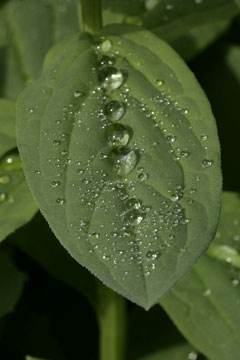
An uncomplicated photograph speaks so much more than a busy one. To me, photography is more of a process of elimination than anything else–getting rid of everything that doesn’t help make the picture stronger and more pleasing for the viewer.
A single leaf with raindrops covering it, a sapling and its shadow on textured snow–these are simple compositions that actually have a lot going on in them when they are viewed closely.
Some places can create a feeling of simplicity more readily than others. Last year at this time, I was leading my Trio of Northern Lights workshops in Alaska, and the article “Winter Solitude” evolved from the experience because of the beauty of the season in that locale.
This year, as I walked around the remote village used for the trip, the idea of simplicity came over me. From the way of life of the handful of residents, to the simplicity of the trees springing up through the snow, to the stark barrenness of the white of winter–everything speaks of simplicity.
There are numerous ways to create a simple photograph. One of the easiest is to shoot in winter, concentrating on a study of trees and their shadows. There is a very strong graphic feel to these shots, even though the only elements in the photo are snow, trees, and shadows.
After a day or two of capturing simple settings in the Northern Lights workshop, participants are surprised to discover they’ve spent as long as several hours in one location when we pack up to move to another spot.
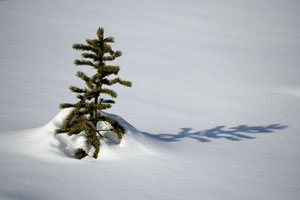
Copyright © Andy Long
Simplicity speaks out with just a small sapling rising out of the snow with it’s trailing shadow.
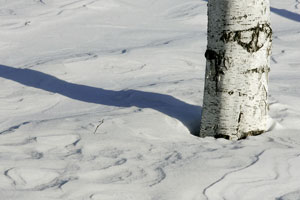
Copyright © Andy Long
Tree trunks & shadows in snow–they call you over to take a shot. At other times of the year the clutter of grass would not allow for that stark image.
Single main subjects in a composition are also a way to create simplicity. With one main subject, there is no other place for the viewer’s eye to go.
A very soft background to isolate the subject also helps. Good ways to do create this effect are to choose a foggy scene, a foreground and background that are very different in color, or to use a shallow depth-of-field. To assist with the shallow depth of field even more, have the subject farther away from the background to create a softer background.
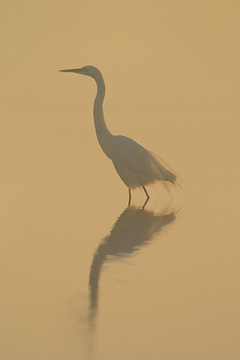
Copyright © Andy Long
Using fog to isolate a subject can create an elegant, soft style to your photography. The single subject attracts the eye of the viewer and holds their attention.
Inserting subtlety in a composition is a way to bring out simplicity. For example, the subtle curve of the tops of a group of trees in the snow that repeats the same curve in the ridge line above it can give a photo more impact, even though the viewers might not realize why they prefer that image over a similar one.
For some, getting the right composition for a shot such as this is not as simple as it is for others. Interacting with a wide array of photographers, I see some who have a good eye for what makes a nice photo while others struggle to get that “just right” setup. However, everyone who does photography has an eye for composition to a certain extent.
If you’re struggling to make a great composition, try to isolate different areas. Look more closely at what drew your interest to your subject in the first place and find a way to bring that out. Sometimes, you’ll find there’s too much going on with competing elements for you to make a simple shot.
Sometimes, the perfect shot just calls out and is very obvious. Sometimes, you just need to do a little bit of searching for that angle, or group, or light, or whatever will create the best shot.

Copyright © Andy Long
The subtlety of the lines between the trees and ridge line add a nice feel to this serene and simple setting.
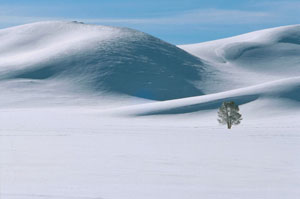
Copyright © Andy Long
Even if the subject is very small in comparison to the overall scene, the eye goes to it because of the contrast from the rest of the scene.
One morning after a rain, a group of participants experienced exactly that challenge during a wildflower workshop when there were raindrops covering lots of bushes of chiming bells. They set out to find a perfect shot for each individual.
They shared their compositional ideas, learned a new technique of combining a 1.4 teleconverter with 25mm extension tubes connected to a macro lens, and a good while later, they all walked away, pleased with their separate results.

Copyright © Andy Long
Taking the time to search out the right subject and the various compositional options can be very rewarding.
Although some of the techniques used in the challenge might have seemed complicated, the photos themselves were quite simple. Different photographers have different definitions of what’s simple and what’s complex.
One time when I tried to explain flash compensation, numerous people grasped the idea right off, but one person didn’t want to go through the multiple steps necessary to take a photo through a window, maintaining good exposure of the inside of the window as well as proper exposure for the scene outside. This person wanted to keep photography at a point-and-shoot level. But if a photographer wants to learn and grow as an artist, she has to achieve certain technical skills.
For good or ill, there’s always more you can learn with photography. Happily, each photographer can choose how much or little she wants to know about taking good shots.
The mechanically inclined enjoy the very technical side of photography and are always looking to move to the next level. To others, these people are extreme and make the work overly complex.

Copyright © Andy Long
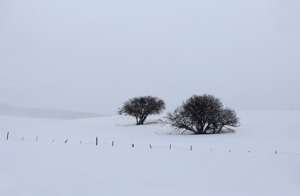
Copyright © Andy Long
Left: Complex yet simple–nothing but shadows & quiet curves on the snow can give one a feeling of calming movement.
Above: Winter shows off a starkness not seen in other seasons.
Enjoyment is the main ingredient in photography, whether the shot is of a simple nature scene, wildlife behavior, people, or any other subject. The day the pure enjoyment of going out and taking pictures disappears is the day that person should put down his camera for good.
Even when things don’t go right and you don’t come home from an outing or trip with great shots, be sure to take delight in the beauty of the area you visit.
Everyone has at least one favorite location where shooting images is just plain fun. After living in Colorado for nearly eighteen years, I moved to another locale that for me, can’t match the number of photo opportunities.
When I plan those visits to Colorado for a few days, I can feel my heart pumping again. Seek out the spots that you love visiting time and again and make it a point to go to them–even if it’s just for a walk. Take in the beauty of each place. Take in the moment. Take in the simplicity of all that is there.
by Andy Long

Leave a Reply